#anne henriette of france
Explore tagged Tumblr posts
Note
The mesdames calling madame de pompadour "maman-putain" is so funny to me. Do you have more random funny shot that they (including their brother) did.
Oh anon I was made for this
Dauphin called Madame de Pompadour I belieave "Madame Pompom"
Adelaide, when she was like 9 to 11, escaped to go "bring back the head of the English king like Judith and Holofernes", I believe she got as far as the stables, where a stablehand had a donkey waiting for her. The book I read this from, I can't remember it's name, said "That's the spirit! Here is a heroine with whom the Judith of Bethulia is only a pale moonlight." and honestly I love it
When Dauphin was a child one of his younger sisters- probably Adelaide given the fact that she was one of the few that he saw as a child -slipped a curse word and he gave her such a bad reprimand that she never forgot it and she started crying
Henriette, Adelaide, and Dauphin's wife, Marie Therese Raphaelle, had a little network trying to get rid of Madame de Pompadour, they were *so* into it, Henriette was the first to call her Maman Putain, and Adelaide and Raphaelle devoted themselves to intel. Adelaide was very young at the time and I imagine that was her first foray into politics
One of Adelaide's governesses when she was a teenager accidentally gave her erotica, although this might be false
When Adelaide and Victoire were on their last leg, living in Naples, they had a concert from the governer of the Count of Chastellux, who played the violin (shittily). It was so bad that Adelaide, who was a violinist so good that even the misogynistic men of the French court (Violin was considered a masculine instrument at the time) admitted she was good, took the violin, playing music. Unfortunately, despite the fun that Adelaide was having- which she sorely needed honestly considering this was after the French Revolution -Duchesse de Narbonne gave her a harsh rebuke because she was a Princess. Apparently, an artist named Goubaud, who I believe is Innocent-Louis Goubaud sketched the scene, but I don't believe we have it anymore.
After Louise went to her convent, Madame Campan, Victoire's lady in waiting, asked if Victoire would ever go to a convent. Victoire assured her that she wouldn't, and said, "Here’s the armchair that ruins me", pointing to the chair she was laying in.
Adelaide was called Madame Torchon by her family and friends, even her older sister Louise Elisabeth called her that in a letter. She called herself it in a letter to the Countesse de Civrac, who I believe at the time was Anne-Marie de La Faurie de Monbadan
If I have more I'll add them!
#aight time to tag#asks#mesdames de france#louis ferdinand of france#louis dauphin of france#dauphin louis of france#madame adelaide#madame de pompadour#anne henriette of france#marie therese raphaelle of spain#María Teresa Rafaela of Spain#louise elisabeth of france#princesses of france#dauphins of france
6 notes
·
View notes
Text

Jean Marc Nattier (French, 1685-1766) Princess Anne-Henriette of France - The Fire, Detail, ca.1750-51 São Paulo Museum of Art
#jean marc nattier#art#fine arts#french princess#french royal#french aristocracy#fine art#french artist#french art#classic art#european art#classical art#europe#european#oil painting#mediterranean#europa#Princess Anne Henriette of France#princess#art history#historical art#france#traditional art#female portrait#female#portrait#brunette#woman#black eyes#powdered hair
25 notes
·
View notes
Text
29 gennaio … ricordiamo …
29 gennaio … ricordiamo … #semprevivineiricordi #nomidaricordare #personaggiimportanti #perfettamentechic
2024: Sandra Milo, pseudonimo di Salvatrice Elena Greco, è stata un’attrice, conduttrice televisiva e personaggio televisivo italiana. Una delle muse di Federico Fellini. La Milo esordì al cinema accanto ad Alberto Sordi. (n. 1933) 2024: Jandira Martini, Jandira Lúcia Lalia Martini, attrice, sceneggiatrice e drammaturga brasiliana. Si laureò in lettere nel 1967, per poi proseguire gli studi di…
#29 gennaio#Alan Ladd#Alan Walbridge Ladd Jr#Annie Wersching#ea7f7f#Enrico Olivieri#Frances Goodrich#George R. Robertson#George Ross Robertson#Helen Darling#Helen Talbot#Howard Hesseman#Jandira Lúcia Lalia Martini#Jandira Martini#Jean-Pierre Aumont#Jean-Pierre Philippe Salomons#Leif Erickson#Marie-Laure de Noailles#Marie-Laure Henriette Anne Bischoffsheim#Nazareno Fonticoli#Ricordiamo#Robert Frost#Sandra Milo#Sara Teasdale#Thelma Furness#Thelma Morgan#Ugo Bologna#Vicomtesse de Noailles#viscontessa Furness#William Wycliffe Anderson
0 notes
Text
Litany of American Saints
(Updated 2024)
In the Name of the Father, and of the Son, and of the Holy Spirit, Amen.
Lord, have mercy on us. Christ, have mercy on us. Lord, have mercy on us. Christ, hear us.
God, the Father of heaven, have mercy on us. God the Son, Redeemer of the world, have mercy on us. God the Holy Spirit, have mercy on us. Holy Trinity, one God, have mercy on us.
Our Lady of Guadalupe, pray for us.
Saint Isaac Jogues, pray for us. Saint René Goupil, pray for us. Saint Jean de Lalande, pray for us. All you holy North American Martyrs, pray for us.
Saint Frances Xavier Cabrini, pray for us. Saint Elizabeth Ann Seton, pray for us. Saint John Neumann, pray for us. Saint Rose Philippine Duchesne, pray for us. Saint Katharine Drexel, pray for us. Saint Mother Théodore Guérin, pray for us. Saint Damien de Veuster of Molokai, pray for us. Saint Marianne Cope of Molokai, pray for us. Saint Kateri Tekakwitha, pray for us. Saint Junípero Serra, pray for us.
Blessed Eduardo Farre, pray for us. Blessed Carlos Manuel Rodriguez, pray for us. Blessed Diego Luis de San Vitores, pray for us. Blessed Francis Xavier Seelos, pray for us. Blessed Lucas Tristany, pray for us. Blessed Carlos Manuel Rodriguez Santiago, pray for us. Blessed Michael McGivney, pray for us. Blessed Sister Miriam Teresa, pray for us. Blessed Stanley Rother, pray for us. Blessed Solanus Casey, pray for us. Blessed Leo William Miller, pray for us.
Venerable Antonio of Jesus, pray for us. Venerable Nelson Baker, pray for us. Venerable Frederic Baraga, pray for us. Venerable Cornelia Connelly, pray for us. Venerable Henriette DeLille, pray for us. Venerable Teresa Demjanovich, pray for us. Venerable Maria Kaupas, pray for us. Venerable Mary Theresa Dudzik, pray for us. Venerable Samuel Charles Mazzuchelli, pray for us. Venerable Mary Angeline Teresa McCrory, pray for us. Venerable Fulton J. Sheen, pray for us. Venerable Pierre Toussaint, pray for us. Venerable Félix Varela, pray for us. Venerable Augustus Tolton, pray for us. Venerable Rafael Cordero Molina, pray for us. Venerable Aloysius Schwarz, pray for us. Venerable Alphonse Gallegos, pray for us. Venerable Patrick Peyton, pray for us. Venerable Norbert McAuliffe, pray for us. Venerable Eusebio Kino, pray for us. Venerable Mary Elizabeth Lange, pray for us. Venerable Rose Hawthorne, pray for us.
Lord, be merciful. Lord, save your people. From all evil, Lord, save your people. From all sin, Lord, save your people. From your wrath, Lord, save your people. From injustice, Lord, save your people. From oppression, Lord, save your people. From hatred and intolerance, Lord, save your people. From anger and ill-will, Lord, save your people. From violence and bloodshed, Lord, save your people. From indifference to suffering, Lord, save your people. From all the snares of the devil, Lord, save your people. By the mystery of your holy Incarnation, Lord, save your people. By your Coming, Lord, save your people. By your Birth, Lord, save your people. By your Baptism and holy fasting, Lord, save your people. By your Cross and Passion, Lord, save your people. By your Death and Burial, Lord save your people. By your holy Resurrection, Lord, save your people. By your wonderful Ascension, Lord, save your people. By the coming of the Holy Spirit, Lord, save your people. On the day of judgment, Lord, save your people.
Be merciful to us sinners, Lord, hear our prayer. That you will spare us, Lord, hear our prayer. That you will pardon us, Lord, hear our prayer. That it may please you to bring us to true penance, Lord, hear our prayer. Guide and protect your Holy Church, Lord, hear our prayer. Preserve in holiness the Pope and all the clergy, Lord, hear our prayer. Humble the enemies of the Church, Lord, hear our prayer. Give peace and unity to the whole Christian people, Lord, hear our prayer. Guide all those who serve us in civil government, Lord, hear our prayer. Protect all those who serve in our armed forces, Lord, hear our prayer. Grant eternal rest to all those who have died in defense of liberty, Lord, hear our prayer. Give courage to those who stand for justice, Lord, hear our prayer. Strengthen and preserve us in your holy service, Lord, hear our prayer. Deliver our souls from eternal damnation, Lord, hear our prayer. Grant eternal rest to all the faithful departed, Lord, hear our prayer. That it may please you to hear and heed us, Jesus, Son of the Living God, Lord, hear our prayer.
Lamb of God, who takes away the sins of the world, spare us, O Lord! Lamb of God, who takes away the sins of the world, graciously hear us, O Lord! Lamb of God, who takes away the sins of the world, have mercy on us.
Christ, hear us. Lord Jesus, hear our prayer. Lord, have mercy on us. Christ, have mercy on us. Lord, have mercy on us.
In the Name of the Father, and of the Son, and of the Holy Spirit, Amen.
25 notes
·
View notes
Text
My two cents that nobody will read.
I liked the series. It was entertaining and interesting. I know it is called Mary and George. Kudos to them to have the guts to show a queer relationship that shaped English history. But the historian student I once was will not rest.
Mary and George:
not historically accurate: Somerset was dismissed with a letter in 1615 after a quarrel and replaced with George immediately. The Overbury trial sealed his fate.
not expanding correctly on James and George's love: we have proof of that, even flamboyant proof.
Mary's role in his son's life wasn't that active: she had bigger fish to fry with the others and she wasn't a lesbian. We have proof. With all the real lesbians and gays and queers of the period, why do we still need to invent them?
The biggest Queen was the King. In Tony Curran's words. He had surely anxiety problems (with his life how could he not) and he suffered of mood swings.
George had three kids and James wasn't that jealous of his wife: she was regularly at court (I know that the night before the wedding James had a breakdown but they were steady with their affections and he got over it).
George and James were promiscuous but so in love with each other that nobody doubted, not even them. Proof in their letters till James' death and in the reports the Venetian ambassador wrote (you can count on Venice's gossip. It was accurate: the Republic's survival depended on it).
No love letters.
Not showing the secret passage.
Not showing that famous speech comparing them to Jesus and John.
No historically accurate petnames.
Buckingham was incompetent on important matters but not a himbo.
Buckingham didn't kill James: there's no proof about this dark legend. He offered him a cup with some medicine in it according to one report. The king suffered from malaria (or what his doctors thought it was malaria) and George didn't kill him in that way in front of a witness like that.
Not showing the part where he stayed on as Charles I's main advisor for some years before being killed: it almost appears he was killed after the coronation.
Not showing La Rochelle's debacle, his games at the French court with Anne of Austria (we have proof of that) and how unequipped he was against Richelieu.
The fashion wasn't that dark. The show is too dark and Nick would have looked attractive with those beards too. Also Somerset had a wrong beard and all (even the Spanish) didn't have those close cropped beards in that fashion. Were are the flamboyant moustaches?
Not showing Charles' wedding with Henriette Marie of France and the fact that George was probably in that marriage too. In what capacity they only know.
Wrong hair colour for Somerset and for Buckingham. One had red hair, the other auburn. Curly or wavy was the fashion.
Not showing that Buckingham was a good friend of Queen Anne. We have proof in affectionate letters in which she asked him to be "always true" to her husband. George was knighted in her bedchamber and she called him "her dog". She didn't care for Somerset. At all.
Sorry for all of this. I encourage you to watch it but after years I am still waiting for a series that will have the guts to show the historical facts for what they were. They were surely wilder than what we see.
#mary and george#I have nothing against the actors#It was very well acted#good job everyone#still waiting for a James and George though#17th century England
50 notes
·
View notes
Text
Collaborative Masterpost on Saint-Just
Primary Sources
Oeuvres complètes available online: Volume 1 and Volume 2
A few speeches
L'esprit de la révolution et de la constitution de la France (1791)
Transcription of the Fragments sur les institutions républicaines (1800) kept at the BNF by Pierre Palpant
Alain Liénard's edition and transcription of his works in Théorie politique (1976)
Some letters kept in Papiers inédits trouvés chez Robespierre, Saint-Just, Payan, etc. (1828)
Fragment autographe des Institutions républicaines
Une lettre autographe signée de Saint-Just, L. B. Guyton et Gillet (not his writing but still interesting)
Two files at the BNF with his writing (and other strange random stuff):
Notes et fragments autographes - NAF 24136
Fragments de manuscrits autographes, avec pièces annexes provenant de Bertrand Barère, de V. Expert et d'H. Carnot - NAF 24158
Albert Soboul's transcription of the Institutions républicaines + explanation of what's in these files at the BNF
Anne Quenneday's philological note on the manuscript by Saint Just, wrongly entitled De la Nature (NAF 12947)
Masterpost (inventory, anecdotes, etc.) - by obscurehistoricalinterests
Chronology
Chronology from Bernard Vinot's biography
Testimonies
Élisabeth Duplay-Le Bas on Saint-Just, as reported by David d'Angers - by frevandrest and robespapier
Élisabeth Duplay-Le Bas corrects Alphonse de Lamartine’s Histoire des girondins (1847) - by anotherhumaninthisworld
Many testimonies by contemporaries (in French) on antoine-saint-just.fr
Representations
Everything Wrong with Saint-Just's Introductory Scene in La Révolution française (1989) - by frevandrest
On Saint-Just's strange representation of "throwing tantrums" - by saintjustitude and frevandrest
Saint-Just as "goth/emo boy"? - by needsmoreresearch, frevandrest and sieclesetcieux
Recommended Articles
Bernard Vinot:
"La révolution au village, avec Saint-Just, d'après le registre des délibérations communales de Blérancourt", Annales historiques de la Révolution française, No. 335, Janvier-Mars 2004, p. 97-110
Alexis Philonenko:
"Réflexions sur Saint-Just et l'existence légendaire", Revue de Métaphysique et de Morale, 77e Année, No. 3, Juillet-Septembre 1972, p. 339-355
Miguel Abensour:
"Saint-Just, Les paradoxes de l'héroïsme révolutionnaire", Esprit, No. 147 (2), Février 1989, p. 60-81
"Saint-Just and the Problem of Heroism in the French Revolution", Social Research, Vol. 56, No. 1, "The French Revolution and the Birth of Modernity", Spring 1989, p. 187-211
"La philosophie politique de Saint-Just: Problématique et cadres sociaux". Annales historiques de la Révolution française, 38e Année, No. 183, Janvier-Mars 1966, p. 1-32. (première partie)
"La philosophie politique de Saint-Just: Problématique et cadres sociaux", Annales historiques de la Révolution française, 38e Année, No. 185, Juillet-Septembre 1966, p. 341-358 (suite et fin)
Louise Ampilova-Tuil, Catherine Gosselin et Anne Quennedey:
"La bibliothèque de Saint-Just: catalogue et essai d'interprétation critique", Annales historiques de la Révolution française, No. 379, Janvier-mars 2015, p. 203-222
Jean-Pierre Gross:
"Saint-Just en mission. La naissance d'un mythe", Annales historiques de la Révolution française, Année 1968, no. 191 p. 27-59
Marie-Christine Bacquès:
"Le double mythe de Saint-Just à travers ses mises en scène", Siècles, no. 23, 2006, p. 9-30
Marisa Linton:
"The man of virtue: the role of antiquity in the political trajectory of L. A. Saint-Just", French History, Volume 24, Issue 3, September 2010, p. 393–419
Misc
Saint-Just in Five Sentences - by sieclesetcieux
On Saint-Just's Personality: An Introduction - by sieclesetcieux
Pictures of Saint-Just's former school, with the original gate - by obscurehistoricalinterests
Saint-Just vs Desmoulins (the letter to d'Aubigny and other details) - by frevandrest
Saint-Just's sisters - by frevandrest
On Thérèse Gellé and Henriette Le Bas - by frevandrest
Saint-Just and Gellé being godparents - by frevandrest and robespapier
On Saint-Just "stealing" and running away to Paris and the correction house - by frevandrest and sieclesetcieux
How was/is Saint-Just pronounced - Additional commentary in French by Anne Quenneday
#saint-just#antoine saint just#saint just#to be updated#masterpost#refs#sources#frev sources#testimonials and commentaries
128 notes
·
View notes
Text



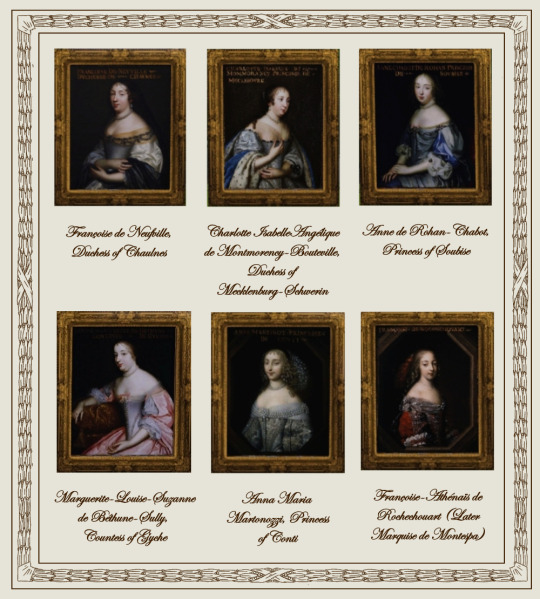


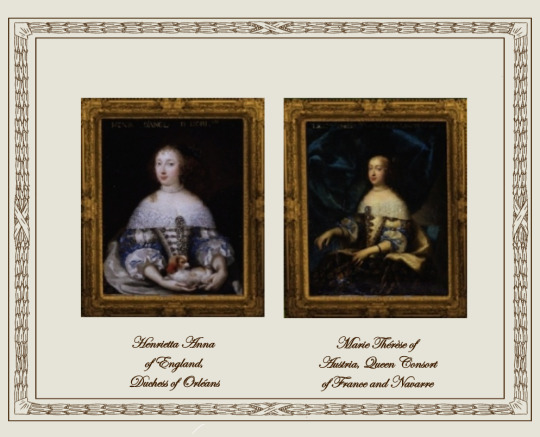
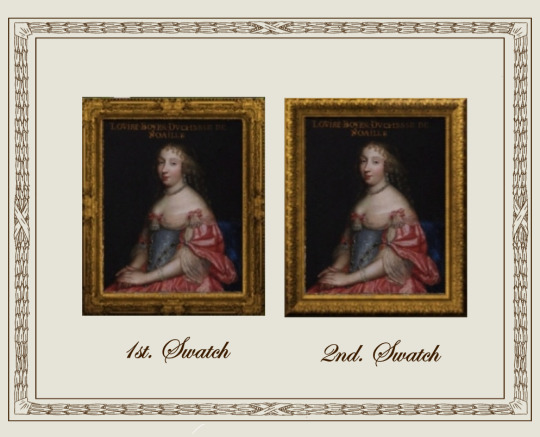
Louis XIV's Gallery of Beauties
A retexture by La Comtesse Zouboff — Original Mesh by @thejim07
This set of 20 portraits was comissioned by the king himself in the 1650s to Charles and Henri Beaubrun (except for a portrait of Henrietta Anna of England, Comissioned to Nicolas Mignard) The portraits comprises the queen, royal princesses and ladies of the court. They hanged at the king's appartments at Versailles. In the 1670s the paintings were progressively relegated to the king's minor residences, but in 1837, Louis-Philippe, King of the French turned Versailles into a museum and rejoined the paintings, in the Louis XIV Rooms, where they remain.
The set includes 20 portraits, with the original frame swatches, fully recolorable. The portraits are of:
Anne Genèvieve de Bourbon, Duchess d'Estouteville and Longueville
Françoise-Athénaïs de Rochechouart (later, Marquise de Montespan)
Anna Martonozzi, Princess of Conti
Anne Louise Boyer, Duchess of Noailles
Anne Marie Gonzaga, Countess Palatine
Anne de Rohan-Chabot, Princess de Soubise
Catherine Henriette d'Harcourt, Duchess d'Arpajon
Catherine de Neuville, Countess d'Armagnac
Charlotte Catherine de Gramont, Proncess of Monaco
Charlotte Isabelle Angélique de Montmorency-Bouteville, Duchess of Mecklenburg-Schwerin
Elizabeth of Orléans, Duchess of Guise and Joÿeuse
Françoise Madeleine d'Orléans (née de Valois) Duchess of Savoy
Françoise Mignot, Mareschalle of l'Hospital
Françoise de Neufville, Duchess of Chaulnes
Gabrielle-Louise de Saint-Simon, Duchess of Brissac
Henrietta Anna of England, Duchess of Orléans
Madeleine-Charlotte d'Albert-d'Ailly, Duchess of Foix
Marguerite Louise d'Orléans, Grand Duchess of Tuscany
Marguerite-Louise-Suzanne de Béthune-Sully, Countess of Gyche
Marie Thérèse of Austria, Queen Consort of France and Navarre
Found under Decor > Paintings for 940 §
Retextured from the "portrait of Anne Marie Louise d'Orléans", found here
Table, torcheres and floor by @thejim07
Rest of the decor by @joojconverts

Drive
(Sims3pack | package)
(Useful tags)
@joojconverts @ts3history @ts3historicalccfinds @deniisu-sims @katsujiiccfinds
-------------------------------------------------------
#the sims 3#ts3#sims 3 cc#portrait#s3cc#sims 3#sims 3 download#sims 3 cc finds#palace of versailles#sims 3 decor#wall decor
43 notes
·
View notes
Note
omg wait so apparently George did sa someone?? what was his ‘relationship’ to Anne? I’m honestly curious if the show is going to include this. In all seriousness though, I don’t think they would. A lot of people have already seen George as just a victim (which in a sense yes because his mother groomed him to use his looks and seduce people to gain power and the fact that the king is 2x his age) but he also doesn’t come off across as completely innocent compared to everyone even though he might not. Im hoping people realize that this show isn’t exactly about ‘romance’ and ship George with people that he’s seducing because I’ve already seen many people just looking forward to mostly the sex part of the story. It also makes sense that they might not include the fact that George attempted to sa Anne in the show because Nicholas is playing him and will make us feel more sympathetic towards George and make King James out to be the bad guy. Honestly it’s kind of sad if they did do that (hopefully not) because the King seems like he’s been through so many traumatic experiences and add on to the fact that he’s insecure about his appearance, has several disabilities (from what I heard), and was desperate to be loved.
I hope I’m not asking to many questions! I’m just really intrigued about it:)
-✨
I don't think they'll show for a simple reason: it happened after the Season Finale.
the last episode is titled "war" and it's implied that the war is the Thirty Years' War, who started in 1618 and involved in his first phase Elizabeth Stuart, james's daughter.
The Amiens night happened in 1616 so... it's difficoult to show it, like the spanish escapade.
George&Anne, so...
They met each other in 1622, during tyhe spanish escapade when george and Charles, at time prince of Wales, travelled to Madrid via France. He found her very beautiful and he wrote to James "if the Infanta is beautiful as his sister we will have a beaitufil queen".
Then they see when george arrived in paris to escort Henriette Anne to London and the flirt, innocent for her, not so inncent for him. She even said "he's the the only man that I can love" but it was a courtley love for her.
The in Amiens he succed to talk with her, alone, thanks to Anne's friend the dutchess of Chevreuse, and... it happened. He tried to kiss her, she refused, he couldn't understand why, he belived " a no is a yes" 'cause no one in over 10 years had dare say no to him, so he continued.
She refused, she fell and he was on top of her, pants down and trying to lift her skirt when her ladies in witing and her butler, found them.
the next day he tried to apologise but the queen mother Marie de'Medici ordred that her daughter had to leave immediatley and never be alone with hime, she and Anne returned to Paris the same day
George was a victim and a culprint too, and this episode really showed that. H was a victim 'cause for 10 years he was spiled by the court, by the prince of wales and by the king so he never heard a no, and he was a culprit 'cause he tried to rape a queen 'cause he cannot understand why a woman could reject him
#mary & george#mary and george#george villiers#queen anne of austria#anne of austria#james i#james vi#james vi and i
4 notes
·
View notes
Text

Henriette:
She was the sister of Louis XIII and the wife of Charles Ist of England. The Maryland is named after her. Her dad died when she was a month old. The Duke of Buckingham was literally trying to seduce her sister-in-law (Anne d'Autriche) and prevent Charles Ist from sleeping with his own wife, which is a lot for one man.
Marie-Thérèse:
First child of Louis XVI and Marie-Antoinette, and the only member of her family to survive the French Revolution, she was left completely alone in her cell as her family was killed or died of mistreatments one after the other. Despite the salic law she was for a while considered an heir presumptive to the throne by royalists as she was, despite her young age, known for her strong morals and her strong will, and so probably a better candidate than the future Louis XVIII. She leaves for Vienna as soon as she is allowed to leave her cell and goes to live at the austrian court.
Dates indicated are dates of life.
4 notes
·
View notes
Text
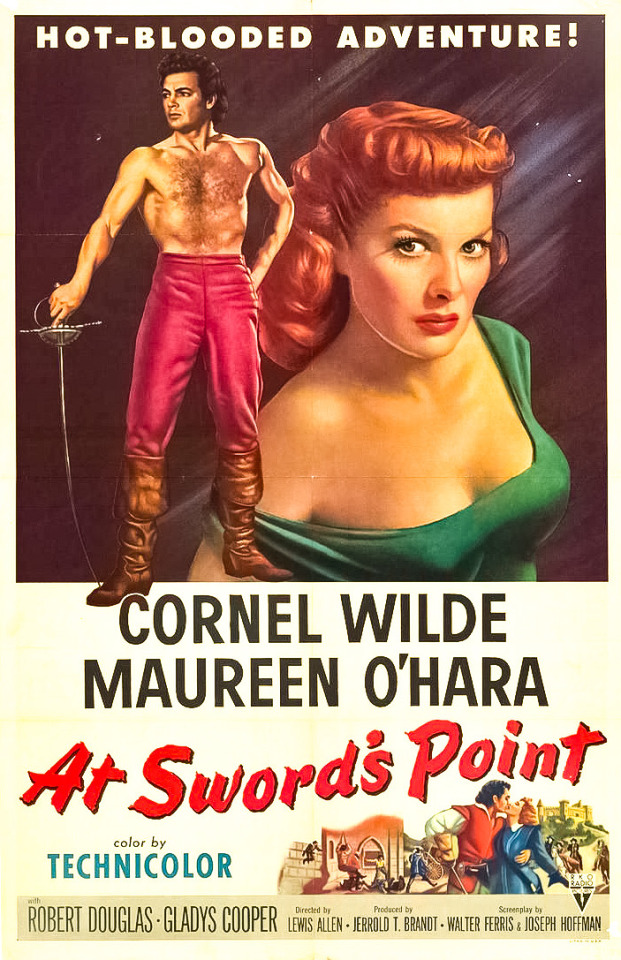
100+ Films of 1952
Film number 118: At Sword’s Point
Release date: Feb 4th, 1952
Studio: RKO
Genre: adventure
Director: Lewis Allen
Producer: Jerrold T. Brandt
Actors: Cornel Wilde, Maureen O’Hara, Gladys Cooper
Plot Summary: In France in 1648, the dying Queen Anne assembles three sons and one daughter of the famous Musketeers to save her empire from the evil clutches of the Duc de Lavalle.
My Rating (out of five stars): *** ¼
This was just light breezy fun. It flew by at only 80 minutes, and it was less stodgy and easier to follow than some historical Hollywood films of the pre-Enlightenment era.
The Good:
Cornel Wilde. I really loved him in The Greatest Show on Earth as the dreamy but wolfish Great Sebastian, and he didn’t disappoint here. He didn’t have much to do, however, but smile confidently and fight with a sword. His charisma unquestionably helped the film overall, though.
Maureen O’Hara. OHMYGOD she looked ga-ga-gorgeous in this! I don’t always love her, but in this she is somehow both smokin’ hot and ethereally beautiful at the same time. Whenever she was dressed up as a “man” in pants and thigh-high leather riding boots, I couldn’t concentrate on anything else!
Alan Hale Jr. as Porthos Jr. Most of us know Hale today as the Skipper on Gilligan’s Island, but here he was the most charming of the sidekick Musketeers. His broad smile and jovial demeanor were perfect for this kind of film.
The lean fast-paced plot. It just whizzed by like a sword swooshing through the- oh god, I can’t be that cheesy!
Sword fights! The swordplay wasn’t as good as in Scaramouche, but what is? This was truly entertaining and more than good enough for a fun little film like this.
I didn’t know RKO made any Technicolor movies, but the color looked great.
I actually liked the storybook-style painted backgrounds and sets, even if they didn’t look super realistic.
I enjoyed the playful energetic score, especially the soaring main theme.
The Bad:
The evil Duc de Lavalle wasn’t well-developed, and that made him less interesting as a villain.
Princess Henriette was a boring character who was unfortunately not played terribly well by Nancy Gates.
The plot could be a little too thin and simplistic at times.
Most of the characters were pretty one dimensional, although you probably would expect that in this kind of film.
O’Hara is supposed to look like a boy sometimes? Enough to actually fool people? Yeah, no.
The movie poster lied- we did not get enough shirtless Wilde in tight pants! I also didn’t love the mullet hair he had. But he’s too beautiful for me to complain about it too much.
#1952#1952 movies#100 films of 1952#maureen o'hara#cornel wilde#200 films of 1952#200 films of 1952 film 118
1 note
·
View note
Note
How badly did Louis xv treat his wife???
Tbh he was more just... Neglectful and ignored her throughout their marriage.
At first, it was very idyllic and they loved each other, but after giving birth the first time to Louise Elisabeth and Anne Henriette, Cardinal Fleury (who absolutely hated her) decided that until she gave birth to a boy, she wouldn't be allowed to leave Versailles. Louis XV did nothing, and it took 3 years for Maria to have a son. Also, what the hell is up with that? She had twin daughters and suddenly she *needs* to have a boy?? Have some patience, she's working on it!
She was very shy, I mean who wouldn't be when faced with the King of France. She wasn't really raised as a Princess- she was raised in a small house with very few servants with her parents, grandmother, and I'm not sure if her sister Anna was dead yet.
Louis XV cheated on her quite a lot, which I know is normal for monarchy but it is worth mentioning. After the birth of Princess Louise (her last child) she almost died, and she was advised to not have anymore children, and after that she refused access to her bedchamber for the King.
One book says,
At certain times, vigils, feasts and days consecrated to the memory of illustrious saints, she demanded- well, let us call it a "respite" from the King's attentions. But gradually new saints of minor importance were invoked, and Louis XV became impatient. He did not chafe at the great elect, but he drew the line at all these petty saintlings. At first he was content with such a device as breathing on a mirror and writing on the fleeting mist, "Your Majesty is a proud minx"; but one night, pleading that it was a saint's day, the Queen refused to admit him to her bedchamber. "Madame," he shouted at her, you shall pay for this," and immediately commanded Lebel to go and fetch a woman, no matter whom. Lebel sped away, and soon returned with an amiable and tantalizing maid of the Princesse de Rohan, who undertook these supplementary duties with the most charming alacrity.
Also after Princess Louise's birth, Cardinal Fleury decided that the budget of Versailles was just too small to handle the extra daughters they had laying around, so obviously something had to be done to them, and not yknow, the king using so much of the budget for frivolous stuff. Adelaide, aged 6, Victoire, 5, Sophie, 4, Felicite, 2, and Louise, under a year old were chosen to leave.
Maria, who had a particular attachment to Adelaide, guided her into running to her father after mass and begging him to let her stay. It worked, but none of her other children were allowed to stay. Despite this, she often sent them gifts, and once they were old enough to yknow, read and write, sent them letters.
One letter from Sophie, which I believe was after Sophie properly met her later on in life, says:
My Dear Mamma, we have been this morning to the Carmelites : they have prayed to God for you, that nothing may happen to you on the road. I am very im- patient to arrive at Versailles ; for I assure you that it concerns me very much not to see you, since I love you, my dear Mamma, with all my heart. Be convinced of this I beg of you.
She loved her children, and they adored her too. Henriette, Louis, Adelaide, and Louis's first wife, Raphaelle particularly defended her against the growing faction of Madame de Pompadour, although their distaste didn't do anything in the eyes of Louis XV. Louis Ferdinand, the Dauphin of France, particularly wasn't very close with his father, seemingly mostly due to Louis XV's treatment of Maria and personality differences.
Louis Ferdinand was a mostly kind-hearted soul who enjoyed gardening, and didn't like hunting or cheating on his wife, which were two things that Louis XV enjoyed very much.
Louis XV comments:
My son is of an indolent disposition, and his temper, like that of most people with Polish blood in their veins, is quick and variable; he has no taste; he cares nothing for hunting, women, or good living. Perhaps he thinks that if he were in my position he would be happy. At first he would change everything, appear to make a fresh start in every particular, and would soon be tired of the position of King as he is now of his own. He is made to live like a philosophe with men of intellect; he likes to do good, he is really virtuous and intelligent.
Unlike what Louis XV thought his son thinks, Louis Ferdinand truly had no desire to reign. Apparently, on a lot of writings to his children, he begins, "If I ever have the misfortune to reign–"
I know this is an abrupt end but I have to leave my house rn- if I have more to add I will reblog!
#marie leszczynska#maria leszczynska#queens of france#louis xv#Sorry for the lack of sources. I have a thing where I drop quotes about historical figures and I have a problem with forgetting to put the#sources too#louis ferdinand of france
9 notes
·
View notes
Text

Jean Marc Nattier (French, 1685-1766) Princess Anne-Henriette of France - The Fire, ca.1750-51 São Paulo Museum of Art
#Nattier#Jean Marc Nattier#french#french art#france#classic art#royal#french aristocracy#aristocrat#french royal#french princess#aristocracy#royalty#noble#nobility#art#1700s#european art#european history#art history#historical art#princess anne henriette of france#fine art#classical art#europe#european#oil painting#fine arts#mediterranean#europa
36 notes
·
View notes
Text
29 gennaio … ricordiamo …
29 gennaio … ricordiamo … #semprevivineiricordi #nomidaricordare #personaggiimportanti #perfettamentechic
2023: Annie Wersching, attrice statunitense. Attiva prevalentemente in televisione, è nota per aver interpretato Amelia Joffe nella soap opera General Hospital, Renee Walker nella serie 24, Lily Salvatore nella serie The Vampire Diaries e la Regina Borg nella serie Star Trek: Picard. Ha iniziato l’attività di attrice nel 2002. Wersching ha sposato l’attore comico Stephen Full nel 2009. La coppia…

View On WordPress
#29 gennaio#Alan Ladd#Alan Walbridge Ladd Jr#Annie Wersching#Enrico Olivieri#Frances Goodrich#George R. Robertson#George Ross Robertson#Helen Darling#Helen Talbot#Howard Hesseman#Jean-Pierre Aumont#Jean-Pierre Philippe Salomons#Leif Erickson#Marie-Laure de Noailles#Marie-Laure Henriette Anne Bischoffsheim#Nazareno Fonticoli#Ricordiamo#Robert Frost#Sara Teasdale#Thelma Furness#Thelma Morgan#Ugo Bologna#Vicomtesse de Noailles#viscontessa Furness#William Wycliffe Anderson
1 note
·
View note
Text

Charles I, son of James VI and I and Anne of Denmark, married Henrietta Maria of France in 1625 and together they had nine children. The first was stillborn, while the second was to become Charles II in 1660, following the rule, primarily, of the Lord Protector, Oliver Cromwell. The third child was a daughter, Mary, Princess Royal, who married William II, Prince of Orange, and the fourth was to become James II of England, the last Catholic King of England. He was deposed in the Glorious Revolution of 1688, which I think I'm right in saying was led by his niece and nephew, Mary and William. Of the remaining children, Elizabeth, Anne, Catherine, Henry Stuart, the Duke of Gloucester, and Henriette Anne, none survived beyond the age of 26.
Notes garnered from the publisher's synopsis and advertising blurbs:
The English Civil War led to the execution of King Charles I in January 1649. He was, even his wife and key advisers conceded, lacking in the essential strength that a ruler required, in turbulent times. But even Charles's enemies were moved by his loving devotion as a father. Sadly, his failure as a king inevitably impacted their lives.
The Restoration of the crown to his eldest son as Charles II occurred eleven years later.
Henrietta Maria was an unpopular but indefatigable Catholic queen.
Their family life was calm and loving until it was shattered by civil war.
Elizabeth and Henry were used as pawns in the parliamentary campaign against their father. [How/in what way?]
Mary, the Princess Royal, was whisked away to the Netherlands as the child bride of the Prince of Orange. ADD LINK TO PREVIOUS POST. [Their son was to become William of Orange, who married his cousin, Mary, daughter of James II. Together they led the Glorious Revolution of 1688 and ruled as Mary II and Wiliam III].
[Presumably during the era of the Protectorate,] Henriette Anne's formidable governess escaped with her, the king's youngest child, to France where she grew up under her mother's thumb and eventually married the cruel and flamboyant Philippe d'Orleans.
When the "dark and ugly" brother Charles eventually succeeded his father to the English throne after fourteen years of wandering [the crown was restored eleven years after his father's execution, so why had he been in exile for fourteen years???], he promptly enacted a vengeful punishment on those who had spurned his family, with his brother James firmly in his shadow.
The book charts the fascinating story of the children of loving parents who could not protect them from the consequences of their own failings as monarchs and the forces of upheaval sweeping England.
SEE PREVIOUS BLOG POST LINK HERE WILL CHECK LATER
0 notes
Text
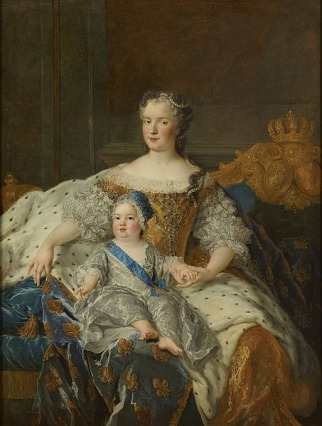
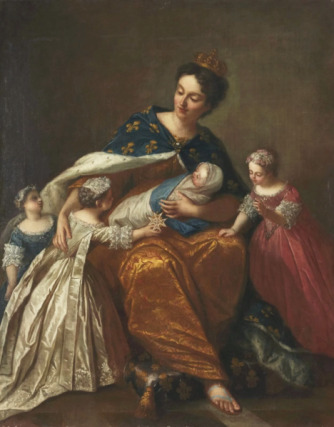
2 portrait paintings of Marie Leszczynska celebrating the birth of the Dauphin, Louis Ferdinand.
The second portrait is of Marie holding the Dauphin, surrounded by her daughters Elisabeth, Henriette and Marie Louise.
Elisabeth and Henriette would have been about 2, Marie Louise would've been about 1.
Marie Louise would die only 3 years later of a cold.
#marie louise of france#louise elisabeth of france#anne henriette of france#louis ferdinand of france#louis dauphin of france#marie leszczynska#marie leczinska#portrait paintings#historical portraits
14 notes
·
View notes
Photo

A portrait of Louise Elisabeth of France and Anne Henriette of France, by Pierre Gobert. The girls were twins, and the two eldest children of Louis XV and Maria Leszczyńska.
Source
#louis xv#maria leszczyńska#louise elisabeth of france#anne henriette of france#18th century#house of bourbon#pierre gobert#long live the queue
159 notes
·
View notes